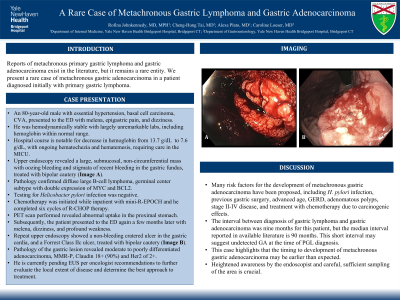Tuesday Poster Session
Category: Stomach
P5077 - A Rare Case of Metachronous Gastric Lymphoma and Gastric Adenocarcinoma
Tuesday, October 29, 2024
10:30 AM - 4:00 PM ET
Location: Exhibit Hall E

Has Audio
- RJ
Rofina Johnkennedy, MD, MPH
Yale New Haven Health, Bridgeport Hospital
Bridgeport, CT
Presenting Author(s)
Rofina Johnkennedy, MD, MPH, Cheng-Hung Tai, MD, Alexa Plato, MD, Caroline Loeser, MD
Yale New Haven Health, Bridgeport Hospital, Bridgeport, CT
Introduction: Reports of metachronous primary gastric lymphoma and gastric adenocarcinoma exist in the literature, but it remains a rare entity. We present a rare case of metachronous gastric adenocarcinoma in a patient diagnosed initially with primary gastric lymphoma.
Case Description/Methods: An 80-year-old male with essential hypertension, basal cell carcinoma, CVA, presented to the with melena, epigastric pain, and dizziness. He was hemodynamically stable with largely unremarkable labs, including hemoglobin within normal range. Hospital course was notable for a decrease in hemoglobin from 13.7 g/dL to 7.6 g/dL, with ongoing hematochezia and hematemesis, requiring care in the MICU. Upper endoscopy revealed a large, submucosal, non-circumferential mass with oozing bleeding and stigmata of recent bleeding in the gastric fundus, treated with bipolar cautery. Pathology confirmed diffuse large B-cell lymphoma, germinal center subtype with double expression of MYC and BCL2. Testing for Helicobacter pylori infection was negative. Chemotherapy was initiated while inpatient with mini-R-EPOCH and he completed six cycles of R-CHOP therapy. PET scan performed revealed abnormal uptake in the proximal stomach. Subsequently, the patient presented to the ED again a few months later with melena, dizziness, and profound weakness. Repeat upper endoscopy showed a non-bleeding cratered ulcer in the gastric cardia, and a Forrest Class IIc ulcer, treated with bipolar cautery. Pathology of the gastric lesion revealed moderate to poorly differentiated adenocarcinoma, MMR-P, Claudin 18+ (90%) and Her2 of 2+. He is currently pending EUS per oncologist recommendations to further evaluate the local extent of disease and determine the best approach to treatment.
Discussion: Many risk factors for the development of metachronous gastric adenocarcinoma have been proposed, including H. pylori infection, previous gastric surgery, advanced age, GERD, adenomatous polyps, stage II-IV disease, and treatment with chemotherapy due to carcinogenic effects. The interval between diagnosis of gastric lymphoma and gastric adenocarcinoma was nine months for this patient, but the median interval reported in available literature is 90 months. The short interval may suggest undetected GA at the time of PGL diagnosis. This case highlights that the timing to development of metachronous gastric adenocarcinoma may be earlier than expected. Heightened awareness by the endoscopist and careful sufficient sampling of area is crucial.
Disclosures:
Rofina Johnkennedy, MD, MPH, Cheng-Hung Tai, MD, Alexa Plato, MD, Caroline Loeser, MD. P5077 - A Rare Case of Metachronous Gastric Lymphoma and Gastric Adenocarcinoma, ACG 2024 Annual Scientific Meeting Abstracts. Philadelphia, PA: American College of Gastroenterology.
Yale New Haven Health, Bridgeport Hospital, Bridgeport, CT
Introduction: Reports of metachronous primary gastric lymphoma and gastric adenocarcinoma exist in the literature, but it remains a rare entity. We present a rare case of metachronous gastric adenocarcinoma in a patient diagnosed initially with primary gastric lymphoma.
Case Description/Methods: An 80-year-old male with essential hypertension, basal cell carcinoma, CVA, presented to the with melena, epigastric pain, and dizziness. He was hemodynamically stable with largely unremarkable labs, including hemoglobin within normal range. Hospital course was notable for a decrease in hemoglobin from 13.7 g/dL to 7.6 g/dL, with ongoing hematochezia and hematemesis, requiring care in the MICU. Upper endoscopy revealed a large, submucosal, non-circumferential mass with oozing bleeding and stigmata of recent bleeding in the gastric fundus, treated with bipolar cautery. Pathology confirmed diffuse large B-cell lymphoma, germinal center subtype with double expression of MYC and BCL2. Testing for Helicobacter pylori infection was negative. Chemotherapy was initiated while inpatient with mini-R-EPOCH and he completed six cycles of R-CHOP therapy. PET scan performed revealed abnormal uptake in the proximal stomach. Subsequently, the patient presented to the ED again a few months later with melena, dizziness, and profound weakness. Repeat upper endoscopy showed a non-bleeding cratered ulcer in the gastric cardia, and a Forrest Class IIc ulcer, treated with bipolar cautery. Pathology of the gastric lesion revealed moderate to poorly differentiated adenocarcinoma, MMR-P, Claudin 18+ (90%) and Her2 of 2+. He is currently pending EUS per oncologist recommendations to further evaluate the local extent of disease and determine the best approach to treatment.
Discussion: Many risk factors for the development of metachronous gastric adenocarcinoma have been proposed, including H. pylori infection, previous gastric surgery, advanced age, GERD, adenomatous polyps, stage II-IV disease, and treatment with chemotherapy due to carcinogenic effects. The interval between diagnosis of gastric lymphoma and gastric adenocarcinoma was nine months for this patient, but the median interval reported in available literature is 90 months. The short interval may suggest undetected GA at the time of PGL diagnosis. This case highlights that the timing to development of metachronous gastric adenocarcinoma may be earlier than expected. Heightened awareness by the endoscopist and careful sufficient sampling of area is crucial.
Disclosures:
Rofina Johnkennedy indicated no relevant financial relationships.
Cheng-Hung Tai indicated no relevant financial relationships.
Alexa Plato indicated no relevant financial relationships.
Caroline Loeser indicated no relevant financial relationships.
Rofina Johnkennedy, MD, MPH, Cheng-Hung Tai, MD, Alexa Plato, MD, Caroline Loeser, MD. P5077 - A Rare Case of Metachronous Gastric Lymphoma and Gastric Adenocarcinoma, ACG 2024 Annual Scientific Meeting Abstracts. Philadelphia, PA: American College of Gastroenterology.
